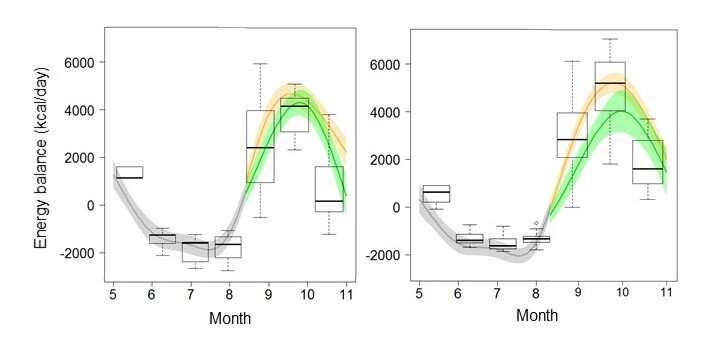Asian black bears' smart strategy for seasonal energy balance

A collaboration led by scientists at Tokyo University of Agriculture and Technology (TUAT), Japan, has discovered that daily energy balance of Asian black bears (Ursus thibetanus) exhibited seasonal change with a twin-peak pattern: up in spring, down to the lowest point in summer, and up again in autumn. From spring to summer, the energy balance is surprisingly negative. Interestingly, bears obtain about 80% of the energy they need in a year by eating acorns in autumn.
Energy balance (i.e., energy intake minus energy usage) is an essential factor when evaluating an animal's nutritional state. "We aimed to identify periods of the year that are most important for Asian black bears in terms of energy balance," said the senior and corresponding author Dr. Shinsuke Koike, associate professor at TUAT. "We estimated daily energy balance of 34 bears fitted with GPS collars in central Japan as follows. Energy intake of bears was estimated using the energy content (kcal/g) of major food items, their average ingestion rate (g/min), and daily feeding time (min). Then, energy usage was calculated by an equation for the costs of resting, traveling, and feeding based on behavioral data monitored by the GPS collars."
Because food habits of bears change seasonally, each month scientists estimated the daily energy balance. Also, because bears change their feeding behavior depending on the availability of hard mast, they made separate estimations for years of good and poor mast conditions during autumn. The scientists then identified major food items from fecal analysis and calculated the gross energy content per unit for each item.
"We have been directly watching bears feeding over 10 years. And we measured ingestion rates of the major food items; acorns on the tree had the highest ingestion rate, while the values of other items did not show notable characteristics," said Koike. "We observed that the variability of energy expenditure rose moderately in good mast years, except for males. On the other hand, there was a twin-peak pattern of energy intake and energy balance, declining from May to July, rising again from August to October, and declining in November."
"Interstingly, only for females, the peak of energy intake and energy balance was larger in good mast years than in poor mast years, while the cumulative energy balance in good mast years was larger than in poor mast years for both females and males. After poor mast years, the cumulative energy balance of males became negative in February, during hibernation, and did not exceed zero until August, even if they could start feeding in May," Koike explains. "Thus, further longitudinal studies that examine cumulative energy balance, rather than energy balance alone, are necessary to clarify the seasonal change in the nutritional state of Asian black bears" adds Koike.
More information: Shino Furusaka et al, Estimating the seasonal energy balance in Asian black bears and associated factors, Ecosphere (2019). DOI: 10.1002/ecs2.2891
Journal information: Ecosphere
Provided by Tokyo University of Agriculture and Technology

















